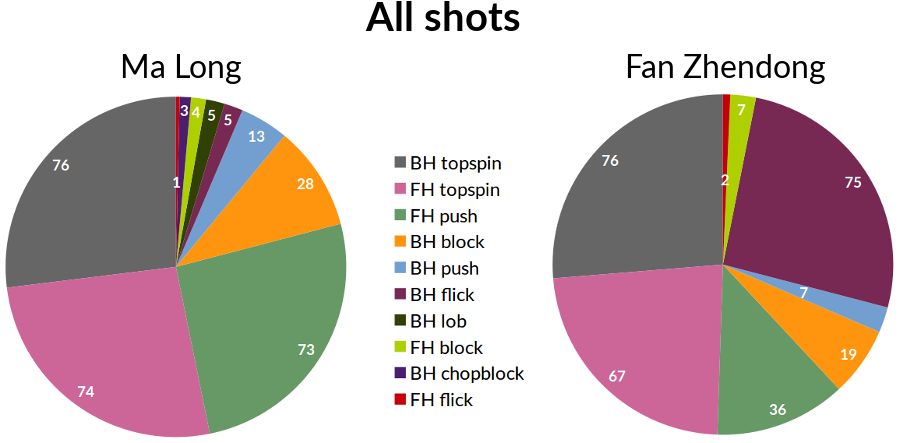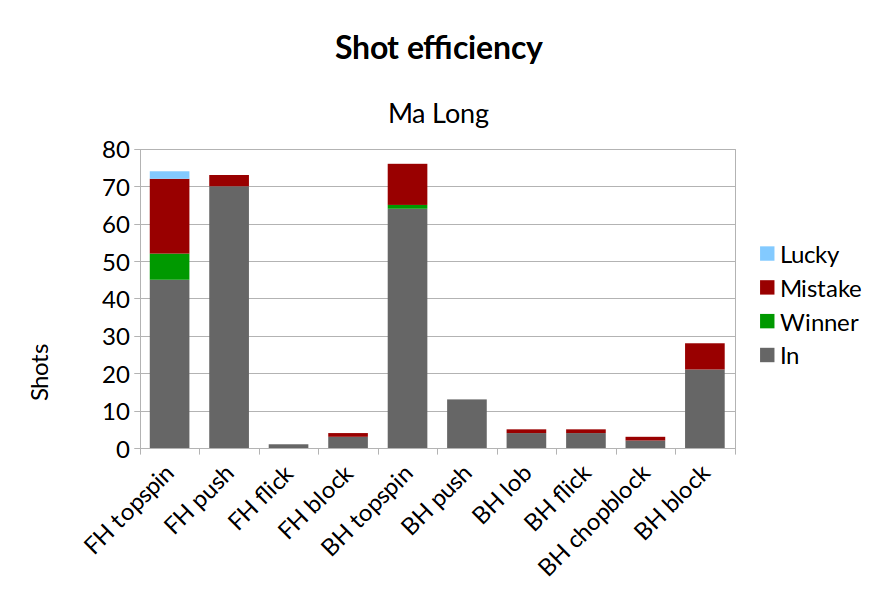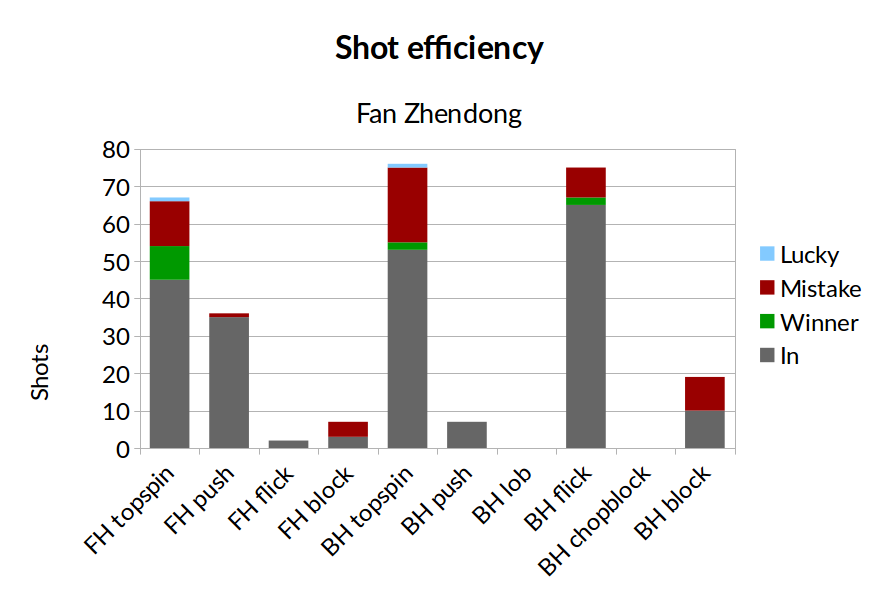
The list of best players in table tennis history is not a difficult thing to agree on: Jan Ove Waldner, Wang Liqin, Vladimir Samsonov and many others. And without a doubt, Ma Long is on that list. However, the real question is: is he at the top of it? Is Ma Long the best player in history?
The 2017 World Table Tennis Championships offered us the chance to enjoy one more exhibition of his current reign. Fan Zhendong, the one deemed to be his successor, reached the final of the Men’s Singles competition with a difficult task: beating Ma Long, the Olympic and World Champion.
In this article, we will analyze this match, trying to spot the key aspects that made the difference for Ma Long to win the championship. As usual, we will craft several graphs and charts to support the arguments and provide interesting insights.
The match
Was it a match or a chess game? After so many previous battles and hundreds of hours training together, nothing unexpected would happen. Ma Long’s comment after the match agrees with this:
“I feel very happy to won, feel I was a bit lucky this time, I am apologetic to Fan Zhendong, but the future belongs to him; mentally I was not certain on how to prepare for the game” – Ma Long
The match result just confirms it: 4-3 (7-11, 11-6, 11-3, 11-8, 5-11, 7-11, 12-10) for Ma Long.
Fan Zhendong started the match as usual: trying to take the point initiative using his backhand flick and using powerful attacks right after that. Five forehand and four backhand mistakes caused Ma Long to lose the first set.
In the second set, Ma Long clearly let Fan Zhendong attack, controlling the short game with well placed pushes. Fan’s backhand flicks did not stop happening, but this time they were less harmful than in the previous set, which allowed Ma Long to counterattack. With 8-6 on the scoreboard, Ma Long took advantage to connect two unstoppable forehand topspins which decided the set. A final 11-6 brought it to 1-1 in the match score.

Fan Zhendong had difficult times ahead if he kept playing that way, so he tried to change several things in the third set. First, he switched from inverted pendulum to a simple pendulum serve. Then, he used more forehand pushes close to the net in order to wait for better attacking opportunities, instead of always flicking the first ball. Apart from that, he sought Ma Long’s forehand. None of these new tactics seemed to work, as Ma Long counteracted them with many rhythm changes and three forehand topspin winners making it an easy set for him: 11-3.
The fourth set of the match was the third in a row for Ma Long, as we got an 11-8 result to reach 3-1 on the scoreboard. A masterclass of tactics, as he used several weapons that left Fan Zhendong in trouble. An example of this happened with 4-2: first a backhand chop-block and then a slow forehand topspin that would mean a 6-2. However, Fan Zhendong kept trusting his style, flicking and looking for backhand to backhand exchanges, which he usually controls. When it was 6-4 for Ma Long, he used his timeout to have a rest and adapt his strategy to prevent the comeback. This he did by pivoting three times, attacking with his forehand and stopping Fan’s domination.
In the fifth set, Fan Zhendong clearly changed his plan again. He continuously attacked to Ma Long’s right corner of the table, who made five mistakes with his forehand topspin which resulted in an easy set for his opponent: 5-11.
The sixth set continued in the same fashion, but Ma Long tried some changes. For the first time in the match he flicked with his backhand to take the initiative. Nonetheless, Fan Zhendong smashed him with parallel backhand shots, like the one he used to finish the set 7-11 to reach the seventh and last.

Fan Zhendong’s start in the seventh set, 2-0 with two parallel and pivoted forehand topspins, did not scare Ma Long. He made some spin variations when pushing that forced unusual mistakes from Fan when flicking with his backhand. Nevertheless, he kept getting points at the forehand side of Ma Long with strong attacks that he could not stop. With 7-7, two similar spinny backhand flicks from Fan Zhendong were not blocked properly by Ma Long, and a 7-9 was set. In that crucial situation, Ma Long trusted his forehand topspin to attack in the first point and then forced a mistake on Fan Zhendong with a strong push in the second one. After a backhand-to-backhand exchange, the first match ball was reached with 10-9 for Ma Long.
The latter made a long serve and pivoted to attack with his forehand. It did not work though, as Fan counteracted it with a troublemaking parallel block and 10-10 was reached to the delight the 8000 spectators in Düsseldorf. The following point was a more unusual backhand flick mistake by Fan Zhendong, and one more match and championship ball for Ma Long. Once again in this situation, he served long and pivoted to attack with his forehand. However, the result was different this time, as Fan could not reach the ball and a final 12-10 ended his dream of becoming the 2017 World Champion.
The match highlights video from the official ITTF channel follows:
The numbers
Let’s first see some general stats about the match:

Although Ma Long won the match and got 4 more points in total, he only had 8 winners, while Fan Zhendong’s power prevailed in this aspect with 13 winners. However, this also made him make more mistakes, 54 vs 45, which explains the final result. Ma Long’s regularity is also proved with a winning streak of 8 points, which he achieved from 5-3 in the second set, that would finish 11-3, to 2-0 in the third.
Regarding the rally length, we have this evolution:

As can be seen, the line has many spikes, which reflects the amount of rhythm changes in the match. The average rally length was 5.6 hits per point, which compared to the Women’s final’s with 7.6, denotes the difference of both categories in the point duration. The first set is the one with the lowest average with 4.9, while the fifth has the highest at 6.7.
Did any of the players control the longest rallies of the match? Let’s take a look at it:
| Rally length | Winner |
| 15 | Fan Zhendong |
| 14 | Ma Long |
| 13 | Fan Zhendong |
| 12 | Fan Zhendong |
| 12 | Ma Long |
| 12 | Fan Zhendong |
| 11 | Ma Long |
| 11 | Fan Zhendong |
| 10 | Fan Zhendong |
| 10 | Ma Long |
| 10 | Fan Zhendong |
| 10 | Ma Long |
| 9 | Ma Long |
| 9 | Fan Zhendong |
| 9 | Ma Long |
| 9 | Fan Zhendong |
Although Fan Zhendong won 4 out of the 6 longest rallies of the match, the numbers get very similar when considering the top 16.
Regarding the kind of shots the players used during the match, we have:

This graph explains the difference that both players have in their style. While both of them have a very similar amount of backhand and forehand topspins, there are two shots which strongly differ: the forehand push and the backhand flick. Ma Long only flicked short balls with his backhand five times in the match, while Fan did it 75 times. What did Ma Long do when returning serves? He used the forehand push 73 times, with different spins and placements to make Fan Zhendong attack in a softer way and counterattack the next ball.
The following video shows how most of the points of the match developed, following a similar pattern:
Let’s see now whether this playing-style difference affected the match result comparing the stroke efficiency of each player:

As aforementioned, Ma Long lost many points when Fan Zhendong attacked to his forehand side of the table. However, the highest amount of winners – seven – also come from this stroke. The backhand-to-backhand rallies were the most repeated sequence during the match, and that’s why so many mistakes happened with Ma Long’s backhand topspins and blocks. This exposes one of his weaknesses compared to Fan Zhendong: the proportion of backhand winners is only 1.3%, while the forehand’s is 9.7%.

Fan Zhendong’s mistakes are fairly divided between forehand and backhand topspins, backhand flicks and backhand blocks. One subtle aspect is hidden in the stats: he had 10 backhand flick mistakes during the whole match, but 3 of them happened at the worst possible moment: the seventh set.
Finally, let’s analyze the importance of attacking first in the match. If we check how often the server won the point, we realize that the service is not a big advantage in top level table tennis nowadays. Ma Long performed 62 services during the match, winning exactly 50% of them: 31. Fan Zhendong won 29 of his services and lost 33.
Was there any difference if we consider the amount of times the first player attacking won the point in the end?

There is a huge gap between both players in the amount of times that each of them iniciated the attacking strokes. However, in both cases, the percentage of points won is almost the same. It is interesting that attacking first meant losing the point more often. This may explain Ma Long’s strategy letting Fan Zhendong attack and waiting to counterattack.
The keys
The match result was very tight. Nonetheless, it was only in the seventh set that they reached a 10-10 result, as the previous sets were resolved much quicker. With a low rally average, most of the points happened close to the table, and that prevented Fan Zhendong from exhibiting his magnificent footwork and caused many mistakes in the backhand-to-backhand exchange. On the other hand, Ma Long struggled with his forehand when Fan Zhendong repeated several parallel shots to that area of the table, and that allowed him to come back from 1-3 down on the set scoreboard.
The seventh, and decisive, set brought several unusual mistakes from Fan Zhendong, who could not take advantage of a leading 7-9 and ended up losing the match. Ma Long described it as being «lucky», but his expertise in these kind of situations was well proven when he finished the match with a surprising forehand parallel topspin that gave him his second World Championship in a row.
It’s about time
Ma Long cheered and celebrated his victory more than we had ever seen before. He still casts a long shadow on the table tennis scene, but time passes and his reign is closer to its end. But, unfortunately for Fan Zhendong, he will now have to wait two more years before the next World Championships to have another chance at defeating Ma Long at a big event.
New faces like Lin Gaoyuan or Tomokazu Harimoto will for sure try to surpass Ma Long and Fan Zhendong so we might not be able to enjoy such a match for a long time. However, this final will always be remembered as one of the best in the World Championships’ history.
* Cover photo: ITTF

Best WTTC final match ever.
LikeLike
It was indeed the best final at a World Champs, at least for a very long time. Thanks for your stats! 😀
LikeLike
the best WC finals 5 sets 2 point decider in the finals and the commentator made the wrong statement of one of the best
LikeLike
I love table tennis statistics keep up the post!!!!
LikeLike